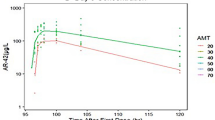Abstract
Drug dose response curves are ubiquitous in cancer biology, but these curves are often used to measure differential response in first-order effects: the effectiveness of increasing the cumulative dose delivered. In contrast, second-order effects (the variance of drug dose) are often ignored. Knowledge of second-order effects may improve the design of chemotherapy scheduling protocols, leading to improvements in tumor response without changing the total dose delivered. By considering treatment schedules with identical cumulative dose delivered, we characterize differential treatment outcomes resulting from high variance schedules (e.g. high dose, low dose) and low variance schedules (constant dose). We extend a previous framework used to quantify second-order effects, known as antifragility theory, to investigate the role of drug pharmacokinetics. Using a simple one-compartment model, we find that high variance schedules are effective for a wide range of cumulative dose values. Next, using a mouse-parameterized two-compartment model of 5-fluorouracil, we show that schedule viability depends on initial tumor volume. Finally, we illustrate the trade-off between tumor response and lean mass preservation. Mathematical modeling indicates that high variance dose schedules provide a potential path forward in mitigating the risk of chemotherapy-associated cachexia by preserving lean mass without sacrificing tumor response.




Similar content being viewed by others
References
Altrock PM, Liu LL, Michor F (2015) The mathematics of cancer: integrating quantitative models. Nat Rev Cancer 15:730–745
Anderson AR, Quaranta V (2008) Integrative mathematical oncology. Nat Rev Cancer 8:227–234
Axenie C et al (2023) Antifragility as a complex system’s response to perturbations, volatility, and time. arXiv preprint arXiv:2312.13991
Axenie C, Kurz D, Saveriano M (2022) Antifragile control systems: the case of an anti-symmetric network model of the tumor-immune-drug interactions. Symmetry 14:2034
Barreto R et al (2016) Chemotherapy-related cachexia is associated with mitochondrial depletion and the activation of erk1/2 and p38 mapks
Bayer P, West J (2023) Games and the treatment convexity of cancer. Dyn Games Appl 13(4):1088–1105
Citron ML (2008) Dose-dense chemotherapy: principles, clinical results and future perspectives. Breast Care 3:251–255
Danchin A, Binder PM, Noria S (2011) Antifragility and tinkering in biology (and in business) flexibility provides an efficient epigenetic way to manage risk. Genes 2:998–1016
Farhang-Sardroodi S, Wilkie KP (2020) Mathematical model of muscle wasting in cancer cachexia. J Clin Med 9:2029
Farhang-Sardroodi S, La Croix MA, Wilkie KP (2022) Chemotherapy-induced cachexia and model-informed dosing to preserve lean mass in cancer treatment. PLoS Comput Biol 18:e1009505
Fearon K et al (2011) Definition and classification of cancer cachexia: an international consensus. Lancet Oncol 12:489–495
Harris LA et al (2016) An unbiased metric of antiproliferative drug effect in vitro. Nat Methods 13:497–500
Jarrett AM et al (2020) Optimal control theory for personalized therapeutic regimens in oncology: background, history, challenges, and opportunities. J Clin Med 9:1314
Köhn-Luque A et al (2023) Phenotypic deconvolution in heterogeneous cancer cell populations using drug-screening data. Cell Rep Methods 3
Meyer CT et al (2019) Quantifying drug combination synergy along potency and efficacy axes. Cell Syst 8:97–108
Naito T et al (2017) Skeletal muscle depletion during chemotherapy has a large impact on physical function in elderly Japanese patients with advanced non-small-cell lung cancer. BMC Cancer 17:1–9
Phoenix WinNonlin User’s Guide (2020)
Piccart M, Biganzoli L, Di Leo A (2000) The impact of chemotherapy dose density and dose intensity on breast cancer outcome: what have we learned? Eur J Cancer 36:4–10
Pin F, Couch ME, Bonetto A (2018) Preservation of muscle mass as a strategy to reduce the toxic effects of cancer chemotherapy on body composition. Curr Opin Support Palliat Care 12:420
Pin F, Barreto R, Couch ME, Bonetto A, O’Connell TM (2019) Cachexia induced by cancer and chemotherapy yield distinct perturbations to energy metabolism. J Cachexia Sarcopenia Muscle 10:140–154
Pineda OK, Kim H, Gershenson C (2019) A novel antifragility measure based on satisfaction and its application to random and biological boolean networks. Complexity 2019
Poterucha T, Burnette B, Jatoi A (2012) A decline in weight and attrition of muscle in colorectal cancer patients receiving chemotherapy with bevacizumab. Med Oncol 29:1005–1009
Sbeity H, Younes R (2015) Review of optimization methods for cancer chemotherapy treatment planning. J Comput Sci Syst Biol 8:74
Schättler H, Ledzewicz U (2015) Optimal control for mathematical models of cancer therapies. An Application of Geometric Methods
Taleb NN (2012) Antifragile: things that gain from disorder, vol 3 (Random House, 2012)
Taleb NN, Douady R (2013) Mathematical definition, mapping, and detection of (anti) fragility. Quant Finance 13:1677–1689
Taleb NN, West J (2023) Working with convex responses: Antifragility from finance to oncology. Entropy 25:343
Vakil V, Trappe W (2021) Dosage strategies for delaying resistance emergence in heterogeneous tumors. FEBS Open Bio 11:1322–1331
West J et al (2021) Antifragile therapy. bioRxiv 2020–10
Wooten DJ, Meyer CT, Lubbock AL, Quaranta V, Lopez CF (2021) Musyc is a consensus framework that unifies multi-drug synergy metrics for combinatorial drug discovery. Nat Commun 12:4607
Acknowledgements
The authors gratefully acknowledge funding by the National Cancer Institute via the Cancer Systems Biology Consortium (CSBC) U01CA232382, U54CA274507; the Physical Sciences Oncology Network (PSON) U54CA193489; and support from the Moffitt Center of Excellence for Evolutionary Therapy.
Author information
Authors and Affiliations
Corresponding authors
Additional information
Publisher's Note
Springer Nature remains neutral with regard to jurisdictional claims in published maps and institutional affiliations.
Supplementary Information
Below is the link to the electronic supplementary material.
Rights and permissions
Springer Nature or its licensor (e.g. a society or other partner) holds exclusive rights to this article under a publishing agreement with the author(s) or other rightsholder(s); author self-archiving of the accepted manuscript version of this article is solely governed by the terms of such publishing agreement and applicable law.
About this article
Cite this article
Pierik, L., McDonald, P., Anderson, A.R.A. et al. Second-Order Effects of Chemotherapy Pharmacodynamics and Pharmacokinetics on Tumor Regression and Cachexia. Bull Math Biol 86, 47 (2024). https://doi.org/10.1007/s11538-024-01278-0
Received:
Accepted:
Published:
DOI: https://doi.org/10.1007/s11538-024-01278-0




